Difference between revisions of "UBPML Referenz"
AndreasLeue (talk | contribs) |
AndreasLeue (talk | contribs) |
||
| Line 65: | Line 65: | ||
|- | |- | ||
| [[Image:UBPMLStepObjectWithConstellations.png]] | | [[Image:UBPMLStepObjectWithConstellations.png]] | ||
| {{T|Eine Instanz eines Schrittes verbunden mit Konstellations-Instanzen. Diese Notation ist bpsw. in Projekt-Diagrammen verwendbar.| | | {{T|Eine Instanz eines Schrittes verbunden mit Konstellations-Instanzen. Diese Notation ist bpsw. in Projekt-Diagrammen verwendbar.|An instance of a Step connected to Constellation instances. This notation is useful e.g. in project diagrams.}} | ||
| UBPML | | UBPML | ||
|- | |- | ||
| [[Image:UBPMLConstellationClassAggregate.png]] | | [[Image:UBPMLConstellationClassAggregate.png]] | ||
| {{T|Stellt die Details einer Konstellation als Aggregation dar: eine Konstellation besteht aus Klassen in einem bestimmten Zustand, diese Klassen werden dargestellt.| | | {{T|Stellt die Details einer Konstellation als Aggregation dar: eine Konstellation besteht aus Klassen in einem bestimmten Zustand, diese Klassen werden dargestellt.|Shows the details of an constellation as an aggregation: a Constellation consistsof classes in a certain state, these classes are shown.}} | ||
| UBPML | | UBPML | ||
|- | |- | ||
| [[Image:UBPMLConstellationObjectAggregate.png]] | | [[Image:UBPMLConstellationObjectAggregate.png]] | ||
| {{T|Stellt die Details einer Konstellations-Instanz als Aggregation dar| | | {{T|Stellt die Details einer Konstellations-Instanz als Aggregation dar|Shows the details of a Constellation instance as an aggregation}} | ||
| UBPML | | UBPML | ||
|- | |- | ||
| [[Image:UBPMLConstellationClassPane.png]] | | [[Image:UBPMLConstellationClassPane.png]] | ||
| {{T|Alternative Darstellungsweise der Details einer Konstellation, entspricht der vorigen Darstellung als Aggregation.| | | {{T|Alternative Darstellungsweise der Details einer Konstellation, entspricht der vorigen Darstellung als Aggregation.|Alternative way of showing the details of a Constellation, corresponds to the previous presentation as an aggregation.}} | ||
| UBPML | | UBPML | ||
|- | |- | ||
| [[Image:UBPMLConstellationObjectPane.png]] | | [[Image:UBPMLConstellationObjectPane.png]] | ||
| {{T|Stellt die Details einer Konstellations-Instanz alternativ dar| | | {{T|Stellt die Details einer Konstellations-Instanz alternativ dar|Alternative way of showing the details of a Constellation instance}} | ||
| UBPML | | UBPML | ||
|- | |- | ||
| [[Image:UBPMLStepWithClassesInState.png]] | | [[Image:UBPMLStepWithClassesInState.png]] | ||
| {{T|Anstelle der Konstellationen können auch die konstituierenden Klassen in einem bestimmten Zustand direkt mit dem Schritt verknüpft werden. Dies ist nur eine Vereinfachung in der Darstellung, implizit werden hierdurch ebenfalls (anonyme) Konstellationen definiert. Wird eine Klasse in einem bestimmten Zustand hierbei mehrfach in unterschiedlicher Bedeutung referenziert, so sind Rollennamen zur Unterscheidung zu verwenden.| | | {{T|Anstelle der Konstellationen können auch die konstituierenden Klassen in einem bestimmten Zustand direkt mit dem Schritt verknüpft werden. Dies ist nur eine Vereinfachung in der Darstellung, implizit werden hierdurch ebenfalls (anonyme) Konstellationen definiert. Wird eine Klasse in einem bestimmten Zustand hierbei mehrfach in unterschiedlicher Bedeutung referenziert, so sind Rollennamen zur Unterscheidung zu verwenden.|Instead of showing a Constellation the constituting classes in a certain state are directly connected to the Step. This is just a simpler way of presentation, there are implicitly (anonymous) Constellations defined, too. If a class in a certain state is referenced multiply in different roles, the rolenames are used to ditinguish this.}} | ||
| UBPML | | UBPML | ||
|- | |- | ||
| [[Image:UBPMLStepWithClassesInStateAlternativeOutcome.png]] | | [[Image:UBPMLStepWithClassesInStateAlternativeOutcome.png]] | ||
| {{T|Da Ergebnisklassen in mehreren Zielkonstellationen auftreten können, müssen diese im Falle der alternativen Darstellung zugeordnet werden können. Dies erfolgt in Form der Angabe der jeweiligen Zielkonstellation als Bedingung.| | | {{T|Da Ergebnisklassen in mehreren Zielkonstellationen auftreten können, müssen diese im Falle der alternativen Darstellung zugeordnet werden können. Dies erfolgt in Form der Angabe der jeweiligen Zielkonstellation als Bedingung an der Relation.|Since one and the same resulting class might exist within several target Constellations, the respective Constellations can be declared as relationship conditions.}} | ||
| UBPML | | UBPML | ||
|- | |- | ||
| [[Image:UBPMLStepAttributes.png]] | | [[Image:UBPMLStepAttributes.png]] | ||
| {{T|Da Schritte auch Klassen sind, können sie wie diese natürlich auch Attribute aufweisen. Die Befüllung der Attribute zu Beginn und zum Ende kann an den Transformations-Relationen angegeben werden.| | | {{T|Da Schritte auch Klassen sind, können sie wie diese natürlich auch Attribute aufweisen. Die Befüllung der Attribute zu Beginn und zum Ende kann an den Transformations-Relationen angegeben werden.|Since Steps are classes, of course they may contain attributes. The initial and final values of these attributes at the beginning and end of the transformation can be specified at the transformation relations.}} | ||
| [[UML]] standard | | [[UML]] standard | ||
|- | |- | ||
| [[Image:UBPMLInstantiation.png]] | | [[Image:UBPMLInstantiation.png]] | ||
| {{T|Durch Angabe einer Multiplizität von 1 am initialen Transformationspfeil auf Seite des Schrittes wird ausgesagt, daß zu jeder Instanz einer Startkonstellation genau ein Schritt existieren soll. Damit wird ausgedrückt, daß automatisch eine Verarbeitung initiiert wird. Alternativ kann durch Angabe einer Zeitfolge (bspw. "jeder 1 Montag im Monat") an einem Timersymbol eine Instantiierung spezifiziert werden, die zeitabhängig erfolgt. Sinnvoll ist dies etwa für Verarbeitungschritte, die eine Prüfung des Vorhandenseins des Rohmaterials beinhalten.| | | {{T|Durch Angabe einer Multiplizität von 1 am initialen Transformationspfeil auf Seite des Schrittes wird ausgesagt, daß zu jeder Instanz einer Startkonstellation genau ein Schritt existieren soll. Damit wird ausgedrückt, daß automatisch eine Verarbeitung initiiert wird. Alternativ kann durch Angabe einer Zeitfolge (bspw. "jeder 1 Montag im Monat") an einem Timersymbol eine Instantiierung spezifiziert werden, die zeitabhängig erfolgt. Sinnvoll ist dies etwa für Verarbeitungschritte, die eine Prüfung des Vorhandenseins des Rohmaterials beinhalten.|A multiplicity of 1 at the initial transformation arrow at the side of the Step says, that for each initial Constellation instance exactly one Step shall exist. In other words, the processing is initiated automatically. Alternatively, by declaring a sequence of points in time (e.g. "1st monday of each month" ) at a timer symbol, a automatically recurring instantiation is defined. E.g., this is useful if the existence of initial raw material is desired.}} | ||
| [[UML]] standard/UBPML | | [[UML]] standard/UBPML | ||
|- | |- | ||
| [[Image:UBPMLProblemStateConditions.png]] | | [[Image:UBPMLProblemStateConditions.png]] | ||
| {{T|Dieses Symbol ordnet eine Fehlerzustands-Bestimmung einer beliebigen Klasse eines UML-Modells zu und stellt lediglich eine vereinfachte Notation von UML Bedingungen dar. Durch Zuordnung dieser Bedingungen zu Schritten können auch problematische Verarbeitungszustände festgelegt und damit auswertbar gemacht werden.| | | {{T|Dieses Symbol ordnet eine Fehlerzustands-Bestimmung einer beliebigen Klasse eines UML-Modells zu und stellt lediglich eine vereinfachte Notation von UML Bedingungen dar. Durch Zuordnung dieser Bedingungen zu Schritten können auch abgestuft problematische - und nicht bloß fatale - Verarbeitungszustände festgelegt und damit auswertbar gemacht werden.|This symbol associates an error state condition to an arbitrary class of a UML model, basically it is just a simplified notation of a UML condition. By associating such conditions to Steps also gradually problematic - and not just fatal - processing conditions can be expressed and made analyzable.}} | ||
| UBPML | | UBPML | ||
|- | |- | ||
| [[Image:UBPMLProblemStates.png]] | | [[Image:UBPMLProblemStates.png]] | ||
| {{T|Mögliche Problem-Zustände.| | | {{T|Mögliche Problem-Zustände.|Possible problem states}} | ||
| UBPML | | UBPML | ||
|- | |- | ||
| [[Image:UBPMLResponsibilities.png]] | | [[Image:UBPMLResponsibilities.png]] | ||
| {{T|Durch Zuordnung eines ''Actors'' zu Verarbeitungsschritten wird dessen | | {{T|Durch Zuordnung eines ''Actors'' zu Verarbeitungsschritten wird dessen Verantwortung ausgedrückt. Es stehen unterschiedliche Verantwortungsarten zur Verfügung.|By attaching ''Actors'' to processing steps it's responsibility is expressed. There are different types of responsibility available.}} | ||
| UBPML | | UBPML | ||
|- | |- | ||
| [[Image:UBPMLResponsibilityTypes.png]] | | [[Image:UBPMLResponsibilityTypes.png]] | ||
| {{T|Mögliche Verantwortungsarten.| | | {{T|Mögliche Verantwortungsarten.|Possible responsibility types.}} | ||
| UBPML | | UBPML | ||
|- | |- | ||
| Line 127: | Line 127: | ||
--> | --> | ||
| [[Image:UBPMLClassInStateInheritance.png]] | | [[Image:UBPMLClassInStateInheritance.png]] | ||
| {{T|Auch Klassen in einem bestimmten Zustand können voneinander abgeleitet werden. Dies bedeutet die Festlegung eines Unter-Zustands.| | | {{T|Auch Klassen in einem bestimmten Zustand können voneinander abgeleitet werden. Dies bedeutet die Festlegung eines Unter-Zustands.|Also classes in a certain state are derivable from each other.}} | ||
| [[UML]] standard | | [[UML]] standard | ||
|- | |- | ||
| Line 137: | Line 137: | ||
--> | --> | ||
| [[Image:UBPMLStepInheritance.png]] | | [[Image:UBPMLStepInheritance.png]] | ||
| {{T|Als Klassen können auch Schritte voneinander abgeleitet werden.| | | {{T|Als Klassen können auch Schritte voneinander abgeleitet werden.|As classes also Steps can be derived from each other.}} | ||
| UBPML | | UBPML | ||
|- | |- | ||
| [[Image:UBPMLFuzzyStates.png]] | | [[Image:UBPMLFuzzyStates.png]] | ||
| {{T|In Projekt-Diagrammen kann es hilfreich sein, die Erreichung eines Zustands partiell anzugeben.| | | {{T|In Projekt-Diagrammen kann es hilfreich sein, die Erreichung eines Zustands partiell anzugeben.|It might be useful in project diagrams to express the completion of a state partially.}} | ||
| UBPML | | UBPML | ||
|- | |- | ||
| [[Image:UBPMLLocationAsState.png]] | | [[Image:UBPMLLocationAsState.png]] | ||
| {{T|Auch "Orte" sind nur eine Sonderform eines Zustands, somit wird der Transfer eines Objekts völlig analog beschrieben.| | | {{T|Auch "Orte" sind nur eine Sonderform eines Zustands, somit wird der Transfer eines Objekts völlig analog beschrieben.|Also "Locations" are just a special kind of States, therefore the transfer of an object is expressed in the same way.}} | ||
| UBPML | | UBPML | ||
|- | |- | ||
| [[Image:UBPMLLocationPane.png]] | | [[Image:UBPMLLocationPane.png]] | ||
| {{T|Mit dieser Notationsform, die nur eine vereinfachende Darstellung ist, wird der Transfer von Objekten übersichtlich dargestellt. Die Darstellung ist bewußt ähnlich zu Swimlanes gehalten.| | | {{T|Mit dieser Notationsform, die nur eine vereinfachende Darstellung ist, wird der Transfer von Objekten übersichtlich dargestellt. Die Darstellung ist bewußt ähnlich zu Swimlanes gehalten.|This notation, which is just a simplifying form, the transfer of objects is shown clearly. The presentation is intentionally similar to swimlanes.}} | ||
| UBPML | | UBPML | ||
|} | |} | ||
Revision as of 18:49, 15 July 2010
UBPML Notation
Download UBPML Notation Overview in PDF format
Notation
|
Semantics
|
Conformity
|
|---|---|---|

|
A class
|
UML standard |

|
An instance of a class
|
UML standard |

|
A class in a certain state
|
UBPML |

|
A class in a certain state. The state itself is also declared here, and that by specifying a condition, which true and only true if that state is given.
|
UBPML |

|
An instance of a class in a certain state.
|
UML standard (seit 2.0 in Aktivitätsdiagrammen) |

|
A certain system state, defined by a set of classes (i.e a Constellation) in certain states, as well as optionally additional constraints that have to be met by that classes and their relationships. A Constellation is a UML class, i.e. dervied from Class in the metamodel.
|
UBPML |

|
An instance of a Constellation, i.e. a set of instances in certain states, which satisfy the constraints of the Constellation-class.
|
UBPML |

|
A Step denotes a change (transformation) of the system from one constellation into possibly several alternative other ones. It is thereby the elementary unit of a planned change. A Step is a UML class, i.e. dervied from Class in the metamodel.
|
UBPML |

|
An instance of a Step. Diagrams containing Step instances may serve to describe Projects. Thereby it is possible to describe Projects and Processes within one uniform notation.
|
UBPML |
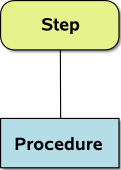
|
A Step describes what shall be done, which change shall happen. It does not fix how this is achieved. The latter happens by assigning a Procedure to the Step. There are different types of Procedures: manual instructions, a refined proceeding or execution of machine operations (invocation of a service). Refined proceedings then may be described with UBPML Steps or BPMN- resp. UML-activities.
|
UML standard |

|
Each Step is associated with exactly one initial Constellation, as well as at least one but possibly several final, mutual exclusive ones. The relationship arrows are borrowed from state transition diagrams (transitions) and named Transformation here.
|
UBPML |

|
An instance of a Step connected to Constellation instances. This notation is useful e.g. in project diagrams.
|
UBPML |
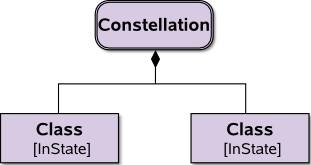
|
Shows the details of an constellation as an aggregation: a Constellation consistsof classes in a certain state, these classes are shown.
|
UBPML |
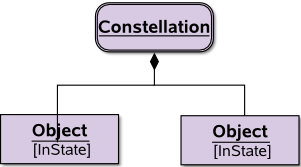
|
Shows the details of a Constellation instance as an aggregation
|
UBPML |
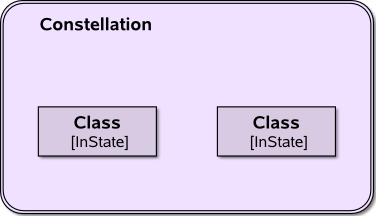
|
Alternative way of showing the details of a Constellation, corresponds to the previous presentation as an aggregation.
|
UBPML |
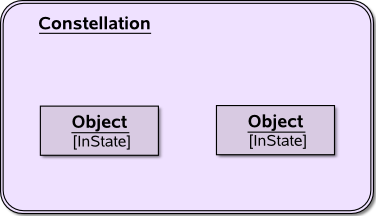
|
Alternative way of showing the details of a Constellation instance
|
UBPML |
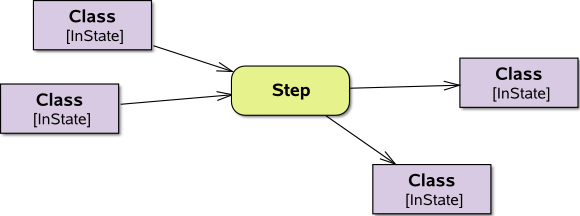
|
Instead of showing a Constellation the constituting classes in a certain state are directly connected to the Step. This is just a simpler way of presentation, there are implicitly (anonymous) Constellations defined, too. If a class in a certain state is referenced multiply in different roles, the rolenames are used to ditinguish this.
|
UBPML |
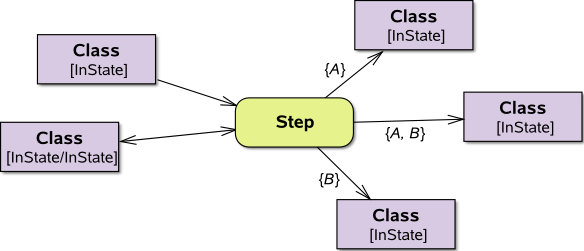
|
Since one and the same resulting class might exist within several target Constellations, the respective Constellations can be declared as relationship conditions.
|
UBPML |

|
Since Steps are classes, of course they may contain attributes. The initial and final values of these attributes at the beginning and end of the transformation can be specified at the transformation relations.
|
UML standard |

|
A multiplicity of 1 at the initial transformation arrow at the side of the Step says, that for each initial Constellation instance exactly one Step shall exist. In other words, the processing is initiated automatically. Alternatively, by declaring a sequence of points in time (e.g. "1st monday of each month" ) at a timer symbol, a automatically recurring instantiation is defined. E.g., this is useful if the existence of initial raw material is desired.
|
UML standard/UBPML |
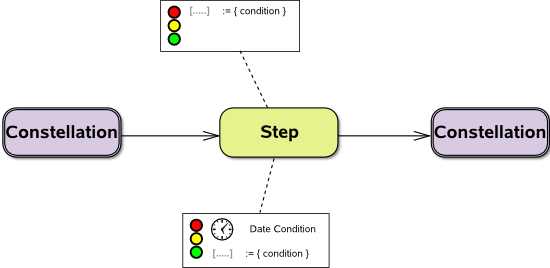
|
This symbol associates an error state condition to an arbitrary class of a UML model, basically it is just a simplified notation of a UML condition. By associating such conditions to Steps also gradually problematic - and not just fatal - processing conditions can be expressed and made analyzable.
|
UBPML |
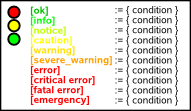
|
Possible problem states
|
UBPML |

|
By attaching Actors to processing steps it's responsibility is expressed. There are different types of responsibility available.
|
UBPML |
Possible responsibility types.
|
UBPML | |
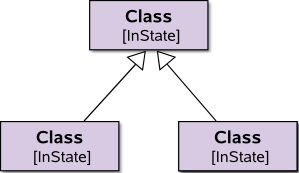
|
Also classes in a certain state are derivable from each other.
|
UML standard |

|
As classes also Steps can be derived from each other.
|
UBPML |

|
It might be useful in project diagrams to express the completion of a state partially.
|
UBPML |
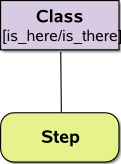
|
Also "Locations" are just a special kind of States, therefore the transfer of an object is expressed in the same way.
|
UBPML |
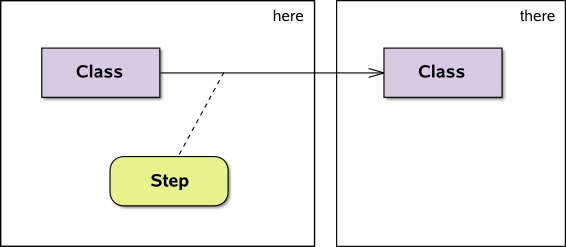
|
This notation, which is just a simplifying form, the transfer of objects is shown clearly. The presentation is intentionally similar to swimlanes.
|
UBPML |